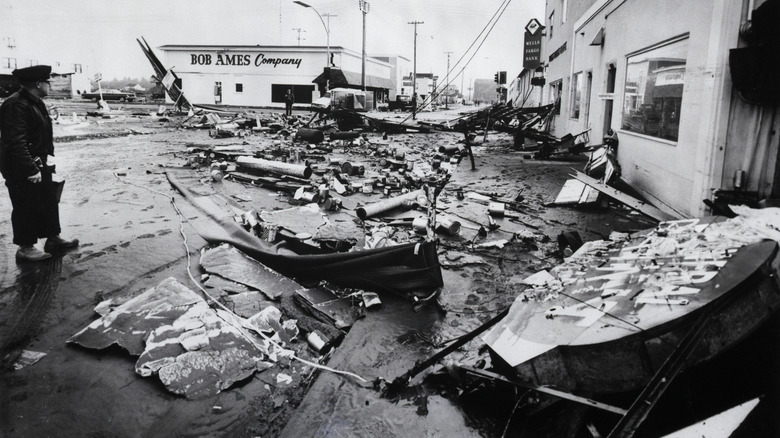When Was The Last Tsunami To Hit California And Could It Happen Again?
When it comes to natural disasters, a tsunami is one of the most destructive and powerful. This series of waves radiates outward from a source, whether it's a volcanic eruption or an earthquake that forms the tsunami. The National Oceanic and Atmospheric Administration ranks the U.S. West Coast at a high to very high hazard level for these incidents, and the most recent one to hit California was in 2022.
On January 15, 2022, the Hunga Tonga-Hunga Ha'apai underwater volcano violently erupted, sending a 600-kilometer-wide plume of ash into the sky, while pressure waves disrupted the entire Pacific Ocean and circled the Earth multiple times. Tide gauges along the California coast recorded maximum wave amplitudes (the difference between sea level and the wave peak) consistent with peak high tide conditions at 1.36 meters in Port San Luis, while the tallest waves (the distance between the wave trough and crest) rose to 2.61 meters. The most damage happened in Santa Cruz and Ventura, but there was minor to moderate flooding on many beaches and harbors.
The NOAA reports that, worldwide, local tsunamis only cause damage about twice a year, and tsunamis only wreak havoc far from their original source about twice per decade around the world. Based on that and the history of tsunamis along California's shores, another tsunami hitting the state is inevitable, although the source and severity will probably differ next time.
The most devastating tsunami to strike the California coast
Since 1800, California has recorded more than 150 tsunamis, but most of them were small and raised water levels only slightly without causing too much damage. Despite that, the state has experienced a few devastating incidents, and the worst of them occurred on March 28, 1964.
A 9.2-magnitude earthquake off the coast of Alaska created the tsunami, and the first two powerful waves struck Crescent City in Northern California while people were evacuated to safety. The first surged about 4.4 meters high with an amplitude of almost 2 meters, while the second was smaller. However, the third wave didn't strike until about 40 minutes after the second, so people were already returning to the shore. It was bigger than the first and knocked over the tide gauge housing. Then, a fourth wave hit, and eyewitnesses said that it was even taller — high enough to surpass the west side of the harbor's sea barrier and to boost the water elevation to almost 6.7 meters. As a result, almost 30 city blocks were flooded and 13 people died. While Crescent City got the worst of it, the entire coast of the state was affected.
The California shoreline is part of the Ring of Fire where the Pacific Plate collides with other tectonic plates and 90% of the world's quakes happen, causing destructive tsunamis in nearby areas. Since local tsunamis are the worst types of tsunamis because they develop close to the source, a similar incident to the 1964 Great Alaska Earthquake and Tsunami could happen again. Fortunately, the warning system has been improved since then to reduce casualties.

